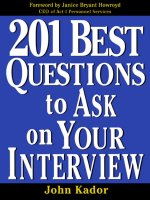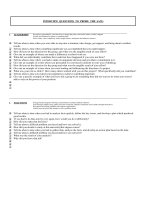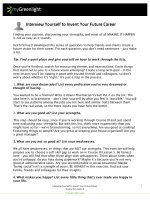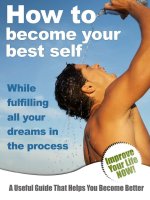201 Best Questions to Ask On Your Interview
Bạn đang xem bản rút gọn của tài liệu. Xem và tải ngay bản đầy đủ của tài liệu tại đây (695.77 KB, 222 trang )
201 BEST QUESTIONS
TO ASK ON YOUR
INTERVIEW
This page intentionally left blank.
201 BEST
QUESTIONS
TO ASK ON YOUR
INTERVIEW
JOHN KADOR
M
C
G
RAW
-H
ILL
NEW YORK CHICAGO SAN FRANCISCO LISBON LONDON
MADRID MEXICO CITY MILAN NEW DELHI SAN JUAN
SEOUL SINGAPORE SYDNEY TORONTO
Copyright © 2002 by The McGraw-Hill Companies, Inc. All rights reserved. Manufactured in the United States of America. Except
as permitted under the United States Copyright Act of 1976, no part of this publication may be reproduced or distributed in any
form or by any means, or stored in a database or retrieval system, without the prior written permission of the publisher.
@Bookz 0-07-140629-8
The material in this eBook also appears in the print version of this title: 0-07-138773-0.
All trademarks are trademarks of their respective owners. Rather than put a trademark symbol after every occurrence of a trade-
marked name, we use names in an editorial fashion only, and to the benefit of the trademark owner, with no intention of
infringement of the trademark. Where such designations appear in this book, they have been printed with initial caps.
McGraw-Hill eBooks are available at special quantity discounts to use as premiums and sales promotions, or for use in corpo-
rate training programs. For more information, please contact George Hoare, Special Sales, at
or (212) 904-4069.
TERMS OF USE
This is a copyrighted work and The McGraw-Hill Companies, Inc. (“McGraw-Hill”) and its licensors reserve all rights in and to
the work. Use of this work is subject to these terms. Except as permitted under the Copyright Act of 1976 and the right to store
and retrieve one copy of the work, you may not decompile, disassemble, reverse engineer, reproduce, modify, create derivative
works based upon, transmit, distribute, disseminate, sell, publish or sublicense the work or any part of it without McGraw-Hill’s
prior consent. You may use the work for your own noncommercial and personal use; any other use of the work is strictly pro-
hibited. Your right to use the work may be terminated if you fail to comply with these terms.
THE WORK IS PROVIDED “AS IS”. McGRAW-HILL AND ITS LICENSORS MAKE NO GUARANTEES OR WAR-
RANTIES AS TO THE ACCURACY, ADEQUACY OR COMPLETENESS OF OR RESULTS TO BE OBTAINED FROM
USING THE WORK, INCLUDING ANY INFORMATION THAT CAN BE ACCESSED THROUGH THE WORK VIA
HYPERLINK OR OTHERWISE, AND EXPRESSLY DISCLAIM ANY WARRANTY, EXPRESS OR IMPLIED, INCLUD-
ING BUT NOT LIMITED TO IMPLIED WARRANTIES OF MERCHANTABILITY OR FITNESS FOR A PARTICULAR
PURPOSE. McGraw-Hill and its licensors do not warrant or guarantee that the functions contained in the work will meet your
requirements or that its operation will be uninterrupted or error free. Neither McGraw-Hill nor its licensors shall be liable to you
or anyone else for any inaccuracy, error or omission, regardless of cause, in the work or for any damages resulting therefrom.
McGraw-Hill has no responsibility for the content of any information accessed through the work. Under no circumstances shall
McGraw-Hill and/or its licensors be liable for any indirect, incidental, special, punitive, consequential or similar damages that
result from the use of or inability to use the work, even if any of them has been advised of the possibility of such damages. This
limitation of liability shall apply to any claim or cause whatsoever whether such claim or cause arises in contract, tort or other-
wise.
DOI: 10.1036/0071406298
To my father,
for modeling so well the responsibilities
and contentments of self-employment.
To my mother,
for teaching me the reasons why
self precedes employment.
And to my entire family
for reminding me that work is play
with a larger social purpose.
This page intentionally left blank.
vii
CONTENTS
Foreword by Janice Bryant Howroyd
ix
Acknowledgments
xiii
Introduction
xv
PART I THE RULES OF THE GAME
1
Chapter 1: Why You Have to Question 3
Chapter 2: Questions You Should Never Initiate 25
Chapter 3: When to Question 35
Chapter 4: Do Your Homework 41
Chapter 5: Do You Mind If I Take Notes? 49
PART II INTERVIEW THE INTERVIEWER
57
Chapter 6: Questions for Headhunters, Recruiters, 59
and Staffing Agencies
Chapter 7: Questions for Human Resources 69
Chapter 8: Questions for Hiring Managers 81
For more information about this book, click here.
Copyright 2002 The McGraw-Hill Companies, Inc. Click Here for Terms of Use.
PART III THE QUESTION LIFE CYCLE
103
Chapter 9: Exploring Questions 109
Chapter 10: Defensive Questions 117
Chapter 11: Feedback Questions 123
Chapter 12: Bid-for-Action Questions 127
Chapter 13: Questions for Superstars 139
Chapter 14: You Got an Offer. Congratulations! 147
Chapter 15: You Blew the Interview. Now What? 153
Index of Questions 161
Index 189
viii
CONTENTS
job, but the path taken—the relationship to work throughout life. And
as John demonstrates so compellingly in this book, empowerment
begins with the questions applicants ask.
So much creativity and insight has gone into the concept of the “in-
formational interview,” thanks largely to Richard Bolles and his mar-
velous classic, What Color Is Your Parachute? For job seekers, the
informational interview at once reduces stress, manages expectations,
and elicits—what else?—information. For the employer, the informa-
tional interview is just as useful.
But John has gone the process one better. In showing job seekers
how to interview interviewers, he has taken the informational inter-
view to the next level. As this practice takes hold, the benefits to em-
ployees and employers alike will be palpable.
How do I know this? Because empowerment doesn’t happen as
some sort of grand revelation; it’s in the details, the small etchings on
the clean slate, the right questions asked in the right way, at the right
time. And because, for me, this process really worked—though I
couldn’t have described it as such at the time.
I was born and went to school in the small community of Tarboro,
North Carolina. I recognized in John’s book a road map of my own
early experiences. As a young girl, I saw how people’s lives were
shaped by their career opportunities, and I sensed that my own ad-
vancement was keyed to the kind of inquisitor I was. As a student in
Project Upward Bound, a program for academically achieving, col-
lege-bound, disadvantaged students, I left North Carolina to expand
my education, eventually working at the National Academy of Sci-
ences in Washington, D.C.
Throughout my journey, one common thread emerged: The quality
of the answers I received was related directly to the pointed nature of
the questions I asked. The more engaged I was, the more those around
me responded. This process was nonverbal as well as verbal. Without
articulating it even to myself, I was advancing my credentials by being
proactive and perhaps, now and again, a bit provocative.
Today, having founded a company in the business of helping people
transform jobs into meaningful careers (and, yes, become empow-
FOREWORD
x
ered), I can say without reservation that even in an unsettled economy,
talent will out. Good people, by definition, take charge. The interview
is your fresh start.
We can thank John Kador that it will never again be a blank sheet.
J
ANICE
B
RYANT
H
OWROYD
Founder, CEO, Chairman, ACT-1 Personnel Services
Torrance, California
FOREWORD
xi
This page intentionally left blank.
ACKNOWLEDGMENTS
Professionals in the staffing industry may be among the hardest-work-
ing people in the world. I am gratified to be able to acknowledge so
many excellent people who carved time out of their busy days to help
me with this book.
To these authorities, staffing professionals all, I express my gratitude:
Anna Braasch, Kimberly Bedore, Janice Brookshier, Kate Brothers,
Robert Conlin, Bryan Debenport, Mariette Durack Edwards, Sandra
Grabczynski, Jeanette Grill, Scott Hagen, Joel Hamroff, Charles Han-
dler, Beau Harris, Bob Johnson, Kathi Jones, Robin M. Johnson,
Richard Kathnelson, Wayne Kale, Houston Landry, Grant Lehman, Joe-
seph LePla, Nancy Levine, Sonja C. Parker, Liz Reiersen, Jason Rodd,
Tony Stanic, Susan Trainer, Tom Thrower, and Robin Upton. On occa-
sion, I chose to ignore their advice and suggestions. If there are errors in
this book, therefore, they are all mine.
Special thanks go to Janice Bryant Howroyd for writing a very per-
sonal Foreword and to Melanie Allred Mays and Gary Ames for giving
my readers the benefit of some sharp intellectual property. Part III of
this book would be impoverished, indeed, without their contributions. I
thank Melanie Mays for the Company Cultural Survey and Gary Ames
and Dr. Wendell Williams for the organization and many of the ques-
tions in Chapters 9–12.
Once again I am indebted to Dr. John Sullivan, professor and head
of Human Resource Management at San Francisco State University, for
sharing with me his experience and perspective on every aspect of the
staffing process. I especially appreciate John for sharing the “superstar”
questions in Chapter 13.
xiii
Copyright 2002 The McGraw-Hill Companies, Inc. Click Here for Terms of Use.
For reading the manuscript and giving me many valuable sugges-
tions, I appreciate Anna Beth Payne, associate director of the Counsel-
ing and Student Development Center, Northern Illinois University, and
Alan Farber, assistant director, Career Planning and Placement Center,
Northern Illinois University, DeKalb, Illinois.
And finally, I’d like to thank the many job seekers on job boards
around the world who contacted me after reading my increasingly des-
perate posts for great and dumb interview questions. Your emails make
an author’s day.
Note to readers: Many of the staffing professionals who helped me
with the book are willing to be resources for readers. Check my Web site
(www.jkador.com) for a list of their contact information.
ACKNOWLEDGMENTS
xiv
INTRODUCTION
The landscape for job seekers today is more treacherous than at any
time in recent memory. In other words, if you want a job today, you
may actually have to work for it.
Just a few months ago, the job interview was an opportunity for
candidates to present their demands and screen the best offers. Today
the tide has turned and employers are running the show again. It’s no
longer enough to be qualified. If you want a job in today’s business en-
vironment, you have to shine in the job interview.
One way to really shine is by asking questions. Questions are the
best way for you to demonstrate that you understand the company’s
challenges, emphasize how you can help the company meet them, and
show your interest in the most unmistakable manner possible—by ac-
tually asking for the position. This book will help arm you with new
interview questions and techniques for selling yourself and getting the
job you want.
After more than a decade of job seekers calling the shots, the col-
lapse of the dot-com economy has resulted in a much more restricted
hiring environment. Employers can now afford to be much more
choosy. With dozens or even hundreds of applicants competing for
every job, employers are raising their standards.
Competition for jobs has never been higher. The ease of recruiting
with the Internet has radically decreased the expense of accumulating
résumés. Today, you are competing not only with other job seekers
from the same community, but with highly qualified people from all
xv
Copyright 2002 The McGraw-Hill Companies, Inc. Click Here for Terms of Use.
over the world. Scared and frustrated, employees still fortunate to have
a job are staying put, decreasing opportunities for career advancement.
For organizations, the stakes for making the right hiring decision
are higher than ever before. Business moves more quickly today than
ever before. Organizations are leaner and more networked. If a criti-
cal task is not performed, the whole operation is at risk of falling apart.
Often a critical hire is all that stands between organizational failure
and success. Organizations today have no guarantee of second
chances. They must get it right the first time.
RAISING THE ANTE FOR JOB SEEKERS
In their struggle to survive, increasingly lean organizations are making
decisions that also raise the ante for job seekers. Companies today are
putting a premium on human productivity. They want to hire people
who can add significant value from day one. Any job candidate who
cannot demonstrate his or her value proposition within a few minutes
into the job interview cannot be expected to advance.
Few organizations today are content to hire merely qualified per-
formers capable of acceptable performance. In a buyer’s market, they
feel they don’t have to settle for anything less than superstars at every
level of the company. These organizations look for individuals who
can demonstrate consistently outstanding results as well as the ability
to stretch well beyond traditional measures of performance. These are
the movers and change agents who can apply thought leadership to the
challenges of the organization.
Interviewers today want to see immediate evidence that you are ac-
tion-oriented, engaged with the long term, committed, zestful, and cu-
rious. These are the attributes that will get you a job. If you act passive,
disengaged, short term–driven, self-centered, and apathetic, you’ll be
passed over. Your ability to ask meaningful questions will tell the in-
terviewer if you project the first set of attributes or the latter.
Does the contemporary job interview seem like a high hurdle to
jump? It is. And you won’t get more than a few minutes to demonstrate
that you are a world-class contributor.
Organizations have beefed up the entire employee selection process
to weed out the amateurs, impostors, and other wanna-bes. The job
INTRODUCTION
xvi
interview has received more than its share of attention as a critical ve-
hicle to achieve organizational goals. If you have been interviewing,
you know that employers have developed dramatically more sophisti-
cated interviewing and selection techniques. You see evidence of these
developments in every aspect of the selection process, from the job in-
terview to exhaustive background checks and drug testing. This book
gives you a shot at understanding what you will be up against in the
new world of job interviews.
Many job hunters think their primary goal is to get to the job inter-
view. Wrong! If you think the primary goal of the job hunter is to get
a job offer, you are getting warmer, but you are still a day late and dol-
lar short. In reality, the primary goal of the job hunter is to get an offer
for a job that is a good fit with his or her short- and long-term re-
quirements—in other words, a position that is sustainable for both the
job hunter and the employer.
To succeed at this part of the job hunt requires the job seeker to in-
terview the interviewer. By this point in the process, the chemistry
between the employer and job seeker should be pretty good. If there
are any remaining candidates, their abilities should be fairly similar, so
you are now competing on softer issues. If you are still in the running,
chances are the employer wants to hire you at least as much as you
want to be hired. Now the tables are turned, and it is your opportunity
to determine if this is the job that’s best for your career. Now you get
to interview the interviewer, and in doing so you have another oppor-
tunity to reinforce your desirability as the best candidate for the job.
This book shows you how.
To ground the book in reality, I’ve asked hundreds of recruiters, job
coaches, and hiring managers for the most memorably good and bad
questions they have heard from job candidates. Some of these ques-
tions are brilliant in their insight, depth, and elegance. Others are just
as effective in terminating the interview with extreme prejudice.
Whether the questions are memorably good or memorably bad, learn
from the former and avoid the latter. The best of these memorable
questions, with comments from the recruiters, are peppered through-
out the book and are separately indexed in the back.
INTRODUCTION
xvii
AN INTERVIEW BETWEEN
THE READER AND THE AUTHOR
A
UTHOR
: Thank you for opening the book. Did you have any trouble
finding it?
R
EADER
: No, the directions you gave me were great. The book was
right there in the Career Section, just where you said it would be.
A
UTHOR
: That’s great. Well, I appreciate your interest in my book.
Please make yourself comfortable. Can I get you a cup of coffee?
R
EADER
: Thank you, no. Maybe later.
A
UTHOR
: As you know, we will be talking to you about buying this
book. This book gives you a powerful approach to job interview-
ing by teaching you to ask questions that put the candidate in the
best light possible. By asking the right questions you can quickly
demonstrate the unique value proposition you alone offer and high-
light why you can immediately ease the business pain of the com-
pany you are interviewing with.
R
EADER
: A problem-solution approach. Sounds promising. Do you
mind if I take notes?
A
UTHOR
: Not at all. Now, we hope to use this exchange to get to know
each other better. Maybe you can start by telling me about how you
expect this book to advance your career objectives.
R
EADER
: In my job interviews, I want to be ready to ask questions of
such intelligence and elegance that they knock the interviewer’s
socks off and immediately set me apart as a force to be reckoned
with.
A
UTHOR
: I like the way you put that.
INTRODUCTION
xviii
R
EADER
: I want my questions to reinforce the reality that I am con-
spicuously the best person for the job and then to ask for the job in
a way that the interviewer will want to endorse my application and
recommend making me the strongest offer possible.
A
UTHOR
: This book will certainly help you do that. At this point, allow
me to describe the book to you in terms of its content and how I
structured it to help you make an immediately favorable impression
at job interviews. In this way, you will have the information you
need to make a determination about whether purchasing this book
will advance your career objectives. Our book-buying philosophy
here at McGraw-Hill is that either a book-buying decision is a good
two-way fit, or it’s not a fit at all. How does that sound?
R
EADER
: It sounds great. May I ask a question?
A
UTHOR
: Yes, of course.
R
EADER
: You asked me about my requirements. What are your re-
quirements?
A
UTHOR
: My requirements are simple. Do you have $12.95?
R
EADER
: Yes.
A
UTHOR
: You’ve satisfied my requirements.
R
EADER
: $12.95? Is that all? I would have thought a book of this earth-
shaking value would cost a lot more.
A
UTHOR
: I appreciate the flattery, but this book is not about sucking
up. Sweet talk is not going to advance your career. Questions
framed with intelligence and presented strategically will. So let me
give you a quick description of what the book offers. The book has
three sections. Part I discusses the rules for asking the best ques-
tions. Chapter 1, “Why You Have to Question,” reviews why it is
imperative to have questions and offers some guidelines for asking
questions in the strongest way possible. Chapter 2, “Questions You
Should Never Initiate,” tells you what subject areas to avoid. Chap-
INTRODUCTION
xix
ters 3, “When to Question,” 4, “Do Your Homework,” and 5, “Do
You Mind If I Take Notes?” deal with the issues of timing, research,
and note taking, respectively.
Part II lists most of the 201 best questions promised in the title.
These are the questions you will use to form the basis of the ques-
tions you ask in your next job interview. Some questions are most
appropriate for different types of interview situations. Chapters 6,
“Questions for Headhunters, Recruiters, and Staffing Agencies,”
7, “Questions for Human Resources,” and 8, “Questions for Hiring
Managers,” list the questions that each of these groups will find
particularly meaningful.
I hope you find Part III especially useful. It deals with the most
common job interview scenarios and recommends killer questions
for each. For example, Chapter 9, “Exploring Questions,” looks at
questions that demonstrate your interest in the job and the company.
Chapter 10, “Defensive Questions,” helps protect you from taking
the wrong job. Chapter 11, “Feedback Questions,” focuses on ques-
tions that allow the interviewer to identify objections so you can
deal with them. Chapter 12, “Bid-for-Action Questions,” suggests
phrasings so you can actually ask for the job, an important step that
most candidates miss.
R
EADER
: I especially appreciate the questions in Chapter 13, “Ques-
tions for Superstars.” Do candidates really ask such in-your-face
questions?
A
UTHOR
: Some do. It’s a question of how confident you are as a can-
didate. Chapter 14, “You Got an Offer. Congratulations!” deals with
the happy outcome that you have received an offer and you want the
job. Naturally you have many questions. Chapter 15, “You Blew the
Interview. Now What?” looks at the near certainty that at least some
of your applications will be rejected. Don’t lose heart. There is still
hope, if not for another shot at the company, then at least a power-
ful learning opportunity.
So that’s how the book is laid out. Any other questions?
INTRODUCTION
xx
R
EADER
: Yes, from what you have just told me, I’m pretty sure that this
book is what I need. So can I buy it, read it, and get back to you
with any remaining questions?
A
UTHOR
: Absolutely. Email me at I welcome your
questions, and I wish you the best in your job search.
J
OHN
K
ADOR
Geneva, Illinois
January 2002
INTRODUCTION
xxi
This page intentionally left blank.
201 BEST QUESTIONS
TO ASK ON YOUR
INTERVIEW
This page intentionally left blank.
Want to learn more?
We hope you enjoy this McGraw-Hill eBook! If
you’d like more information about this book, its
author, or related books and websites, please
click here
.









